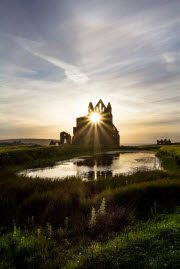
"Whitby Abbey Summer
Solstice" (taken June 2014)
Reproduced with kind
permission: Si's Photography
Click for full-sized image.
The official start of summer in the northern hemisphere commences on June 21st – the date of the summer solstice this year, when the Sun reaches its greatest altitude on the ecliptic; the path it takes across the sky during a year. From our latitude this equates to almost 59 degrees above the southern horizon at midday. The word ‘solstice’ is derived from the Greek for ‘Sun’ and ‘stoppage’. From our perspective the Sun stops moving north in the sky and starts to retreat southwards once again as the axial tilt of Earth begins to shift away from the direction of the Sun.
Many people wrongly assume that Earth is closer to the Sun at this time of year; in fact the opposite is true. Earth is actually furthest from the Sun on July 4; almost 95 million miles distant, three million miles further than when at its closest approach in early January? The reason days feel warmer in summer is due to the higher concentration of sunlight per unit area as a result of the axial tilt toward the Sun. The intensity of solar radiation is then equivalent to approximately 1.2KW of heat for each square metre, although in recent years this seems hard to comprehend?
Although known as the longest day, earliest sunrise and latest sunset do not fall on the summer solstice date. From Whitby earliest sunrise actually occurs on June 16th at 04:25am, whilst latest sunset occurs on June 25th at 21:42pm. It is the duration of useable daylight which does reach a maximum on the 21st, equating to around 17 hours from our latitude. Then the Sun only dips below the horizon a meagre 12 degrees, barely enough for nautical twilight to exist.
Thousands of years ago the position of the summer solstice stood before the stars of Cancer in the northern hemisphere, but has subsequently shifted due of the effects of precession, Earth’s slow axial wobble. From our latitude the Sun never appears overhead, but may do so anywhere between latitude 23.5 degrees North and latitude 23.5 degrees South, casting no shadows, a phenomena astronomers in antiquity duly noted. Because the summer solstice then stood before Cancer, the latitude of 23.5 degrees north eventually became known as the tropic of Cancer. Similarly then, the Sun then stood before the stars of Capricorn when at its southern limit on the ecliptic (the winter solstice) 23.5 degrees south of the celestial equator and the origin of the tropic of Capricorn.
- Log in to post comments

